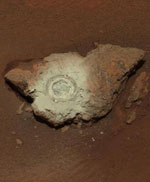
Image credit: NASA/JPL
As both rovers approach their third month resident on Mars, the mission planners have returned to Earth time. Both rover teams look to make rapid progress toward distant hills, with a possible second September extension continuing with any remaining mission science.
JPL Mars Program Office Head, Dr. Firouz Naderi, indicated that with this week’s first mission extension, even more may be planned. Currently slated for September 13 as the next mission milestone, such an ambitious science schedule would give the rovers 250 Sols on the planet’s surface. “This is all bonus science,” said Naderi. “After the solar conjunction (alignment between Mars, Earth and the Sun) around September 13th, we would probably propose to NASA for a second extension.” During a solar conjunction, explained Naderi, the Sun blocks line-of-sight views between the Earth tracking and martian surface operations for seven to ten days. “The Sun gets in the way,” said Naderi, explaining that during the lead-up to September 13th, both rovers will be given a deserved weeklong respite, followed by what many hope will be further healthy science operations to follow.
For the rest of 2004, the engineering and science team will look to stretch more life out of their six-wheeled laboratories. The primary constraints on further operations will be thermal, power, and dust accumulation from seasonal change and road weathering. Mission manager, Matt Wallace, explained previously that both rovers were healthy: “We try to keep our finger on the pulse of vehicle health, looking for signals or markers of subtle changes and trends. Except for environmental changes (power, thermal, optical opacity and dust accumulation), there is no wear and tear on subsystems.”
At Gusev crater, the extended Spirit mission will look to traverse towards Columbia Hills. At Meridiani Planum, the extended Opportunity mission will rack up long drives across the flat plains towards Endurance Crater. At full speed, the rovers can clock from 50 to 100 meters per Sol.
Naderi noted that the switch of mission personnel back to Earth time has been a welcome transition. For future missions, he said, the consensus for long-term operations will likely move away from following Mars’ sunrise and sunset times. One problem other than the late and early on-site shifts at JPL has been the inability to sleep at consistent times because the approximately 39 minute longer martian day continues always to push and rotate schedules. Dr. Ray Arvidson, deputy Principal Investigator and Washington University, St. Louis professor of geology, compared the hectic three months on Mars time to jetlag when a transatlantic traveler returns from Europe. “It takes three to four days to get back to Earth time,” said Arvidson.
One other benefit, according to Arvidson, is that since mission science is planned for Spirit and Opportunity on opposite sides of Mars, now that both teams work on the same clock, they will be able to simplify coordination and strategic science targets. There are people on the other rover tream, said Arvidson, “who I haven’t seen for three months except in the parking lot.”
Spirit’s mission manager for surface operations, Jennifer Trosper, noted that on her first day back on Earth time (last Monday), she was pleased not to come into work at 1 A.M. But as she was getting ready for bed that night proved to be exactly when she was called back to JPL–to troubleshoot why the Spirit rover had not responded to a ‘beep’ signal sent from Earth around midnight.
Trosper said that new flight software will be a major priority for the coming days. She explained that while there were risks associated with any commands that change the rovers’ state, the software has been thoroughly pre-tested. The first upload of flight software was not loaded until only one month before launch. The critical descent and landing software was not loaded on the spacecraft until nearly three months after launch, while the probe was well on its way to Mars.
In detail, Trosper noted, their plan will feature first the transfer of software command files for six hours a day over 4 days of direct communication from Earth to the high-gain antenna on both rovers. “When we get all the files on-board, then we build the flight software (locally on the rovers). When that is complete, the rovers go to sleep for 15 minutes, waking up with a new system.” The Spirit rover was the first to encounter file overloads after 18 days of file storage, and at one point could not send any data to Earth except that its system clock had shifted to the year 2053. Later changes in software succeeded in rejoining the rovers with JPL’s command center.
Arvidson highlighted a few near-term science objectives as further investigation on Spirit continues to calibrate the dusty martian skies. By pointing the rover’s panoramic camera towards the sky, while overhead satellites look down, scientist hope to remove the masking influence of dust. Spirit completed these coordinated observations with the thermal emission spectrometer instrument on NASA’s Mars Global Surveyor orbiter. The observations involved miniature thermal emission spectrometer pre-flight, simultaneous, and post-flight sky and ground measurements. Spirit also collected a panoramic camera opacity observation.
Opportunity continues to surprise scientists as it found another outcrop similar to what was first seen in its landing hole at Eagle Crater. But this time, the outcrop is on the edge of a trough in the middle of the plains. “This outcrop looks texturally like Eagle Crater,” and current plans are to spend several days probing what appears to be bedrock. Bedrock is of interest if it has preserved a layered timeline of rock deposit. Since this deposit also has ripples, scientists hope to discover whether its chemistry “speaks to water,” said Arvidson. “The trough is probably a fracture, we don’t know how young?”
While there is a “strong desire to get another 100 meter drive, to get to Endurance Crater,” said Arvidson, “the hope is to spend a few Sols here.”
Original Source: NASA/JPL News Release
